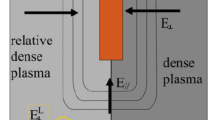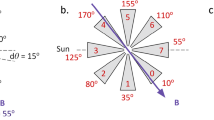Abstract
The bright night-time aurorae that are visible to the unaided eye are caused by electrons accelerated towards Earth by an upward-pointing electric field1,2,3. On adjacent geomagnetic field lines the reverse process occurs: a downward-pointing electric field accelerates electrons away from Earth4,5,6,7,8,9,10,11. Such magnetic-field-aligned electric fields in the collisionless plasma above the auroral ionosphere have been predicted12, but how they could be maintained is still a matter for debate13. The spatial and temporal behaviour of the electric fields—a knowledge of which is crucial to an understanding of their nature—cannot be resolved uniquely by single satellite measurements. Here we report on the first observations by a formation of identically instrumented satellites crossing a beam of upward-accelerated electrons. The structure of the electric potential accelerating the beam grew in magnitude and width for about 200 s, accompanied by a widening of the downward-current sheet, with the total current remaining constant. The 200-s timescale suggests that the evacuation of the electrons from the ionosphere contributes to the formation of the downward-pointing magnetic-field-aligned electric fields. This evolution implies a growing load in the downward leg of the current circuit, which may affect the visible discrete aurorae.




Similar content being viewed by others
References
Reiff, P. H. et al. Determination of auroral electrostatic potentials using high- and low-altitude particle distributions. J. Geophys. Res. 93, 7441–7465 (1988).
Block, L. P. & Fälthammar, C.-G. The role of magnetic field-aligned electric fields in auroral acceleration. J. Geophys. Res. 95, 5877–5888 (1990).
McFadden, J. P., Carlson, C. W. & Ergun, R. E. Microstructure of the auroral acceleration region as observed by FAST. J. Geophys. Res. 104, 14453–14480 (1999).
Chiu, Y. T., Newman, L. & Cornwall, J. M. On the structures and mapping of auroral electrostatic potentials. J. Geophys. Res. 86, 10029–10037 (1981).
Klumpar, D. M. & Keikkila, W. J. Electrons in the ionospheric source cone: Evidence for runaway electrons as carriers for downward Birkeland currents. Geophys. Res. Lett. 9, 873–876 (1982).
Gorney, D. J., Chiu, Y. T. & Croley, D. R. Jr Trapping of ion conics by downward parallel electric fields. J. Geophys. Res. 90, 4205–4210 (1985).
Marklund, G. T., Blomberg, L. G., Fälthammar, C.-G. & Lindqvist, P.-A. On intense shock-like electric fields associated with black aurora. Geophys. Res. Lett. 21, 1859–1862 (1994).
Marklund, G. T., Blomberg, L. G., Fälthammar, C.-G., Lindqvist, P.-A. & Eliasson, L. On the occurrence and characteristics of intense low-altitude electric fields observed by Freja. Ann. Geophys. 13, 704–712 (1995).
Marklund, G., Karlsson, T. & Clemmons, J. On low-altitude particle acceleration and intense electric fields and their relationship to black aurora. J. Geophys. Res. 102, 17509–17522 (1997).
Carlson, C. W. et al. FAST observations in the downward auroral current region: energetic upgoing electron beams, parallel potential drops, and ion heating. Geophys. Res. Lett. 25, 2017–2020 (1998).
Ergun, R. E. et al. FAST satellite observations of electric field structures in the auroral zone. Geophys. Res. Lett. 25, 2025–2028 (1998).
Alfvén, H. On the theory of magnetic storms and aurorae. Tellus 10, 104–116 (1958).
Borovsky, J. E. Auroral arc thicknesses as predicted by various theories. J. Geophys. Res. 98, 6101–6138 (1993).
Carlqvist, P. & Boström, R. Space-charge regions above the aurora. J. Geophys. Res. 75, 7140–7146 (1970).
Boström, R. Voltage drops along auroral magnetic field lines on small and large scale. Phys. Space Plasmas 15, 37–42 (1998).
Temerin, M. & Carlson, C. W. Current–voltage relationship in the downward auroral current region. Geophys. Res. Lett. 25, 2365–2368 (1998).
Rönnmark, K. Electron acceleration in the auroral current circuit. Geophys. Res. Lett. 26, 983–986 (1999).
Wygant, J. R. et al. Polar spacecraft based comparisons of intense electric fields and Poynting flux near and within the plasma sheet tail lobe boundary to UVI images: An energy source for the aurora. J. Geophys. Res. 105, 18675–18692 (2000).
Keiling, A. et al. Properties of large electric fields in the plasma sheet at 4-7 RE measured with Polar. J. Geophys. Res. 106, 5779–5798 (2001).
Escoubet, C. P., Russel, C. T. & Schmidt, R. (eds) The Cluster and Phonix Missions. Space Sci. Rev. 79 (1/2), 1–658 (1997).
Issue on Cluster first results. Ann. Geophys. 19 (October/November 2001).
Karlsson, T. & Marklund, G. Simulations of effects of small-scale auroral current closure in the return current region. Phys. Space Plasmas 15, 401–406 (1998).
Vasyliunas, V. M. in Particles and Fields in the Magnetosphere (ed. McCormac, B.) 60–71 (Reidel, Dordrecht, 1969).
Lysak, R. L. Electrodynamic coupling of the magnetosphere and ionosphere. Space Sci. Rev. 52, 33–87 (1990).
Acknowledgements
We are indebted to H. Frey for providing the IMAGE data for the event, and G. Gustavsson who was the Principal Investigator for the Electric Field and Wave (EFW) instrument until 2000.
Author information
Authors and Affiliations
Corresponding author
Ethics declarations
Competing interests
The authors declare no competing financial interests.
Rights and permissions
About this article
Cite this article
Marklund, G., Ivchenko, N., Karlsson, T. et al. Temporal evolution of the electric field accelerating electrons away from the auroral ionosphere. Nature 414, 724–727 (2001). https://doi.org/10.1038/414724a
Received:
Accepted:
Issue Date:
DOI: https://doi.org/10.1038/414724a
- Springer Nature Limited
This article is cited by
-
Quiet, Discrete Auroral Arcs: Acceleration Mechanisms
Space Science Reviews (2020)
-
Quiet, Discrete Auroral Arcs—Observations
Space Science Reviews (2020)
-
Altitude of the upper boundary of AAR based on observations of ion beams in inverted-V structures: A case study
Science China Earth Sciences (2016)
-
Localization of 3D inertial Alfvén wave and generation of turbulence
Astrophysics and Space Science (2015)
-
Electric Fields and Plasma Processes in the Auroral Downward Current Region, Below, Within, and Above the Acceleration Region
Space Science Reviews (2009)





